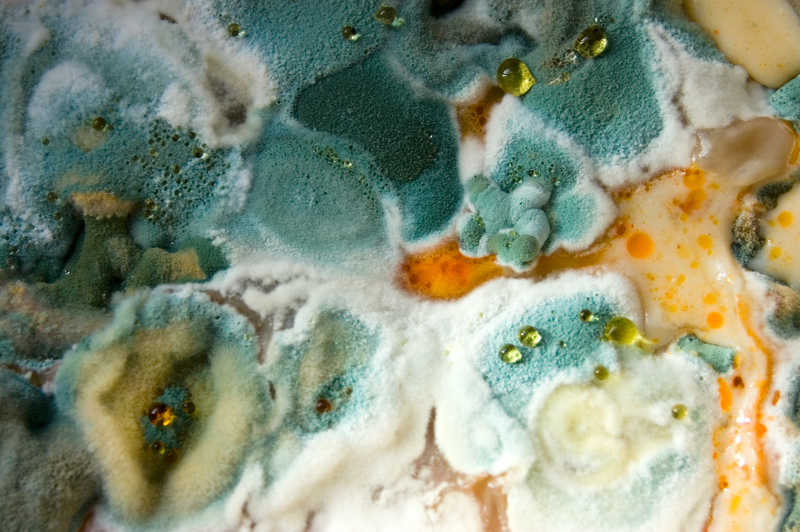Homemade penicillin is something you may need during true emergency situations. It should be used to reduce or prevent infections from starting.
There’s a simple but less reliable way of making penicillin, and then there are steps that you can take to ensure that your end result is penicillin. Warning: though: it’s complicated and requires chemicals that can be quite expensive and have limited shelf lives.
Equipment needed:
A gram scale
Separatory funnel
A 1-liter glass container
750 ml Erlenmeyer flask with a non-absorbent plug
A pH test kit
2 pieces of whole wheat bread
A cantaloupe rind, more bread, or citrus fruit
Step 1 – Set out the rind, bread or fruit and let it mold (we’ll call this the host). It will go through a few phases. First the mold will be white or gray, then it will turn blue, then a bright blue-green. This is the color you want. Note: if you choose to use bread, it’s best to make it yourself because many bakeries use an ingredient that inhibits mold growth.Step 2 – Sterilize the flask by putting it in the pressure cooker at 15 lb. for at least 15 minutes, or bake it at 315 degrees F for an hour.
Step 3 – Cut the whole wheat bread (see note in step 1) into 1/2-inch cubes and place them in the flask, careful to be as sterile as you can.
Step 4 – scrape the blue-green mold from the host and place it in with the bread. Again, be as sterile with this step as you can, for instance, boil the tongs that you’re using.
Step 5 – Place the flask in a dark place that’s around 70 degrees and allow it to incubate for 5 days.
At this point, some people may say that you’re done and you can just slap the “penicillin” on the wound or make tea or soup from the bread. We don’t recommend it.
Step 6 – Now it’s going to get complicated. You’re going to need the following ingredients:
Lactose Monohydrate 44 gm
Corn Starch 25 gm
Sodium Nitrate 3 gm
Magnesium Sulfate 0.25 gm
Potassium Monophosphate 0.50 gm
Glucose Monohydrate 2.75 gm
Zinc Sulfate 0.044 gm
Manganese Sulfate 0.044 gm
Now, according to the instructions that I found (neither of which were actual medical sites because, as usual, there aren’t any actual medical sites that describe how to make anything like this at home), it says to dissolve these in tap water.After researching, it seems that distilled water would be the best to use for the next step because we want to keep things as sterile as possible and tap water has unknown variables. That’s just my opinion and I’m definitely not a formally trained scientist, so use what you prefer.
Step 7 – So, back to it. Sterilize the 1+ liter container, then dissolve the above ingredients in 500 ml of cold water. Add more cold water to make it a full liter.
Step 8 – Use hydrochloric acid (HCL) to adjust the pH to 5.0-5.5 using your pH test kit.
Step 9 – Sterilize the container along with the solution as described above.
Step 10 – Allow the solution to cool, then add the mold. Incubate it for another 7 days under the same conditions as before. It’s important that the fluid isn’t jostled around so put it where it won’t be moved.
If you’ve done it correctly, you’re almost done. Now it’s time to extract the penicillin that’s infused in the fluid.
Step 11 – Filter the mix through a coffee filter or sterilized cheesecloth.
Step 12 – Adjust the pH of the solution to 2.2 using the HCL and the pH test kit.
Step 13 – Mix with cold ethyl acetate in the separatory funnel and shake vigorously for 30 seconds or so then allow it to separate. The ethyl acetate will be at the bottom.
Step 14 – Chill a beaker in an ice bath and drain the ethyl acetate into it. Add 1 percent potassium acetate and mix it again.
Step 15 – Let the ethyl acetate evaporate off while the solution is still in the beaker. You want plenty of air circulating through.
Step 16 – You have penicillin, assuming you did everything right. Actually the crystals that remain are potassium penicillin and potassium acetate.
This is a pretty scientific process and not something that you should undertake lightly, just to save yourself a few bucks on a prescription.
Learning how to make your own medicine from scratch may seem like more trouble than it's worth, but it may be something that could save a life. Plus, learning how to do something like this could be a useful skill when a collapse takes place. You can learn more about this method straight from the source Surviviopedia.com.

Too bad penicillin will kill me. I suppose it would be good for barter
To much for shif.
Almost every pathogen is resistant to common penicillin on bread. We are now up to 5th generation penicillins. All man made. Disinformation could get people killed. Please ask a microbiologist before spreading this. You may be able to grow it, but it has not effect on almost all pathogens. They are resistant.
Kristen Marie Townsend
Bev Bell
Where on earth do you get those raw chemical ingredients if SHTF?
Question: are fish antibiotics safe for human consumption?
This is potentially dangerous advice.
Carl Ginzel
Kerri Walker
Heard no.
Totally unrealistic ! Oh Yeah….I’ve got all this equipment in the bathroom…..NOT !
thanks eric
Depends on who you ask; many swear by stocking up on them.
https://www.thebugoutbagguide.com/fish-antibiotics-for-humans/
Blanca Sanchez